Surgical outcome of epicanthus and telecanthus correction by C-U medial canthoplasty with lateral canthoplasty in treatment of Blepharophimosis syndrome
- PMID: 35590300
- PMCID: PMC9118630
- DOI: 10.1186/s12886-022-02455-2
Surgical outcome of epicanthus and telecanthus correction by C-U medial canthoplasty with lateral canthoplasty in treatment of Blepharophimosis syndrome
Abstract
Purpose: To evaluate the surgical outcome of epicanthus and telecanthus correction by C-U medial canthoplasty with lateral canthoplasty in Blepharophimosis Syndrome.
Patients and methods: This was a retrospective single arm interventional study including 18 eyes of 9 patients with Blepharophimosis-ptosis-epicanthus inversus syndrome who presented to oculoplastic clinic, ophthalmology department, Qena university hospital in the period of between July 2020 to April 2021. All the patients had BPES with epicanthus and telecanthus. All cases were subjected to by C plasty with medial and lateral canthoplasty for correction of epicanthus and telecanthus correction followed by frontalis suspension surgery to correct the co-existing blepharoptosis.
Results: The study included 9 cases of BPES, 6 boys and 3 girls, the mean age was 5.4 ± 1.5 in the study group, all patients had a positive family history for BPES. After surgery, the mean IICD decreased from 38.44 mm preoperatively to 32.8 mm postoperatively, with a mean difference of 6.2 mm (P < 0.001). Likewise, the mean PFL increased from 20.78 mm preoperatively to 26.63 mm postoperatively, with a mean difference of 5.8 mm (P < 0.001). Epicanthus skin fold disappeared in all cases and medical canthus could be seen with well healed difficulty seen scars.
Conclusion: C-U medial canthoplasty with lateral canthoplasty in Blepharophimosis Syndrome was found to be an effective procedure in the correction of epicanthus and telecanthus.
Keywords: Blepharophimosis Syndrome; C-U medial canthoplasty; Epicanthus; Telecanthus; lateral canthoplasty.
© 2022. The Author(s).
Conflict of interest statement
The authors declare that they have no competing interests.
Figures




Similar articles
-
Surgical Outcome of Epicanthus and Telecanthus Correction by Double Z-Plasty and Trans-Nasal Fixation with Prolene Suture in Blepharophimosis Syndrome.J Clin Diagn Res. 2017 Mar;11(3):NC05-NC08. doi: 10.7860/JCDR/2017/25651.9496. Epub 2017 Mar 1. J Clin Diagn Res. 2017. PMID: 28511421 Free PMC article.
-
A modified staged surgical intervention for blepharophimosis-ptosis-epicanthus inversus syndrome: 125 cases with encouraging results.Ann Plast Surg. 2015 Apr;74(4):410-7. doi: 10.1097/01.sap.0000437072.17014.41. Ann Plast Surg. 2015. PMID: 24164792
-
[Management of blepharophimosis, ptosis, epicanthus inversus syndrome at a referral center in Tunisia].J Fr Ophtalmol. 2021 Jan;44(1):53-62. doi: 10.1016/j.jfo.2020.03.021. Epub 2020 Dec 2. J Fr Ophtalmol. 2021. PMID: 33279286 French.
-
[Blepharophimosis ptosis epicanthus inversus syndrome (BPES) (corrected)].Klin Monbl Augenheilkd. 2012 Jan;229(1):28-30. doi: 10.1055/s-0031-1281864. Epub 2012 Jan 12. Klin Monbl Augenheilkd. 2012. PMID: 22241538 Review. German.
-
Blepharophimosis, Ptosis, and Epicanthus Inversus Syndrome.2004 Jul 8 [updated 2022 Mar 10]. In: Adam MP, Feldman J, Mirzaa GM, Pagon RA, Wallace SE, Amemiya A, editors. GeneReviews® [Internet]. Seattle (WA): University of Washington, Seattle; 1993–2025. 2004 Jul 8 [updated 2022 Mar 10]. In: Adam MP, Feldman J, Mirzaa GM, Pagon RA, Wallace SE, Amemiya A, editors. GeneReviews® [Internet]. Seattle (WA): University of Washington, Seattle; 1993–2025. PMID: 20301614 Free Books & Documents. Review.
References
-
- Blair VP, Brown JB, Hamm WG. Correction of ptosis and of epicanthus. Arch Ophthalmol. 1932;7(6):831–846. doi: 10.1001/archopht.1932.00820130015001. - DOI
MeSH terms
Supplementary concepts
LinkOut - more resources
Full Text Sources
Miscellaneous

